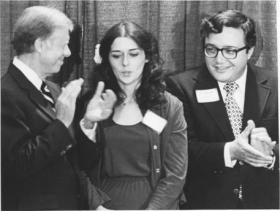This blog post was written by Lois Gibbs, consultant with the CrossCurrents Foundation and Executive Director of the Center for Health, Environment, & Justice.
No, I’m not talking about a shot of whiskey. I’m referring to the way change happens.
Thirty-five years ago at Love Canal, in Niagara Falls, NY, my working class community introduced the nation, and to some extent the world, a new understanding of how environmental chemicals adversely impact people’s health. Love Canal is a toxic waste dumpsite containing over 20,000 tons of chemicals, which leaked into the surrounding residential neighborhood where residents developed an alarming number of health problems that they believed were caused by chemicals leaking from the landfill. At the time, state health investigators repeatedly told residents that it was unlikely that their health problems are related to Love Canal since their exposures were much lower than workplace standards.
Yet the evidence was strong. One study found that 56% of the neighborhood children born in one stretch had birth defects. Not willing to accept that environmental chemicals were responsible, investigators concluded the birth defects were more likely caused by a “random clustering of genetically defected people.” Leaders at Love Canal refused to accept this explanation and organized protests, forums and accountability hearings, some targeting the Governor and even President Carter’s re-election campaign. Eventually, health investigators were forced to accept that chemicals from the leaking dumpsite did cause serious public health problems. In the wake of Love Canal came other communities like Woburn, MA where 28 children developed leukemia from drinking contaminated water. Ann Anderson, a mom with a sick child, knocked on doors, circulated a petition and followed the blue print of Love Canal until authorities acknowledged the connection between the well water and the childhood cancers.
Grassroots leaders and workers have amplified awareness of the impact of environmental chemicals on health. You see this clearly today with consumers demanding information on chemicals in products such as biphenol-A in baby products or PVC in children’s toys as workers did years earlier when they won the right-to-know.
Love Canal, Woburn and workers have all helped set the stage for new chemical policy and labeling reforms that are now moving at various levels of government. Those directly affected have always inspired, energized and led a broad range of supporters in successful movements throughout history, such as anti-slavery, women's suffrage, labor rights and civil rights. A foundation I work with, CrossCurrents Foundation, has joined a number of other funders including members of HEFN that invests heavily in non-partisan civic participation knowing that change begins at the bottom where alliances are built.
Still the front line groups are the very groups within the health and environmental movement that are starved for resources. In a report last year, the National Committee for Responsive Philanthropy detailed how many environmental funders mainly support large, professionalized environmental organizations instead of grassroots, community-based groups heavily affected by environmental harm (Also see this recent blog post). Organizations with annual budgets greater than $5 million make up only 2% of all environmental groups, yet they receive more than 50% of all grants and donations. The report makes a profound argument that the current funding strategy is not working and that, without targeting philanthropy at the community level, the movement will not succeed.
Investing in building capacity at the local and state level can lead to the significant change needed to protect public health, the environment and our democracy. The time to make this investment is now.
Lois Gibbs is the Executive Director of the Center for Health, Environment & Justice and consultant with the Cross Currents Foundation. Thirty-five years ago, she helped lead the Love Canal neighborhood of Niagara Falls, NY's fight for state, local and federal recognition and action on health problems caused by toxic chemical leakage from the landfill on which the neighborhood was built.


